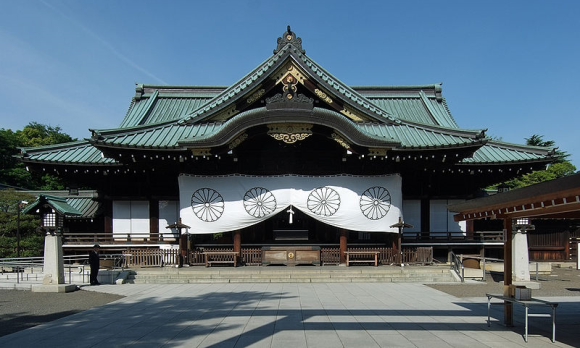
Explosion occurred at controversial Yasukuni religious site roughly two weeks ago.
Last month, on the morning of November 23, an explosive device was set off on the grounds of Yasukuni Shrine. Yasukuni, located in Tokyo’s Chiyoda Ward, enshrines the souls of all those who were killed fighting for Japan in conflicts that have occurred since the start of the country’s Meiji Period in the mid-19th century.
After being contacted by a construction worker who heard the explosion, the police conducted a search of the Yasukuni Shrine grounds on the 23rd, discovering a 30-centmeter (11.9-inch) square hole blown out of the ceiling of a public restroom, as well as four pipes bound together with a lead wire attached, scorched batteries, and what appeared to be a digital display. Thankfully, no injuries were reported, despite a larger than usual number of visitors being at the shrine to attend the annual Niinamesai rice harvest ceremony which was being held that day.
Upon examining surveillance footage recorded in the area, Tokyo Metropolitan Police claim to have identified Changhan Jeon, a 27-year-old Korean national, leaving the scene shortly after the explosion. Jeon had checked into a hotel in Chiyoda Ward on the night of November 22, but left Japan following the blast on November 23, departing Tokyo’ Haneda Airport on a flight back to Korea.
However, Jeon returned to Japan, again passing through Haneda Airport, on the morning of December 9. Upon arrival, he was met by the authorities and promptly arrested.
No motive has been suggested, but considering the sharply divided political opinions Yasukuni is a lightning rod for, displeasure at Japan’s military aggressions towards Korea in the first half of the 20th century is likely the supposition the police are operating under. Jeon has denied the charges, responding to questioning with the phrase “Yoku wakaranai” (“I don’t know” or “I’m not sure”), and remains in police custody.
Source: NHK News Web via Jin
Top image: Wikipedia/Wiiii

 Police respond to explosion, suspected bombing at Yasukuni Shrine in central Tokyo
Police respond to explosion, suspected bombing at Yasukuni Shrine in central Tokyo Company known for Pokémon cards and toys under fire for tweet about visiting Yasukuni Shrine
Company known for Pokémon cards and toys under fire for tweet about visiting Yasukuni Shrine Increased security measures could bode longer lines at Comiket
Increased security measures could bode longer lines at Comiket Sakura report 2019: First cherry blossoms begin to bloom in Tokyo
Sakura report 2019: First cherry blossoms begin to bloom in Tokyo “Long Live China!”: Chinese players hijack Tokyo’s Yasukuni Shrine Pokémon Go gym
“Long Live China!”: Chinese players hijack Tokyo’s Yasukuni Shrine Pokémon Go gym Japanese ramen restaurants under pressure from new yen banknotes
Japanese ramen restaurants under pressure from new yen banknotes McDonald’s new Happy Meals offer up cute and practical Sanrio lifestyle goods
McDonald’s new Happy Meals offer up cute and practical Sanrio lifestyle goods Tokyo Tsukiji fish market site to be redeveloped with 50,000-seat stadium, hotel, shopping center
Tokyo Tsukiji fish market site to be redeveloped with 50,000-seat stadium, hotel, shopping center New private rooms on Tokaido Shinkansen change the way we travel from Tokyo to Kyoto
New private rooms on Tokaido Shinkansen change the way we travel from Tokyo to Kyoto French Fries Bread in Tokyo’s Shibuya becomes a hit on social media
French Fries Bread in Tokyo’s Shibuya becomes a hit on social media Mt. Koya planning to instate visitor’s tax to cope with huge tourist numbers
Mt. Koya planning to instate visitor’s tax to cope with huge tourist numbers Japanese company starts project to restore Nakagin Capsules to capsule hotel
Japanese company starts project to restore Nakagin Capsules to capsule hotel Beautiful Red and Blue Star luxury trains set to be Japan’s new Hokkaido travel stars
Beautiful Red and Blue Star luxury trains set to be Japan’s new Hokkaido travel stars Secret Kitchen bento serves Japanese flowers, birds, wind and moon in a box, but is it worth it?
Secret Kitchen bento serves Japanese flowers, birds, wind and moon in a box, but is it worth it? Sakura tree falls on man at Sannenzaka near Kiyomizu temple in Kyoto 【Breaking News】
Sakura tree falls on man at Sannenzaka near Kiyomizu temple in Kyoto 【Breaking News】 All-you-can-drink Starbucks and amazing views part of Tokyo’s new 170 meter-high sky lounge
All-you-can-drink Starbucks and amazing views part of Tokyo’s new 170 meter-high sky lounge More foreign tourists than ever before in history visited Japan last month
More foreign tourists than ever before in history visited Japan last month Starbucks reopens at Shibuya Scramble Crossing with new look and design concept
Starbucks reopens at Shibuya Scramble Crossing with new look and design concept Studio Ghibli releases new action figures featuring Nausicaä of the Valley of the Wind characters
Studio Ghibli releases new action figures featuring Nausicaä of the Valley of the Wind characters Studio Ghibli glasses cases let anime characters keep an eye on your spectacles
Studio Ghibli glasses cases let anime characters keep an eye on your spectacles Is the new Shinkansen Train Desk ticket worth it?
Is the new Shinkansen Train Desk ticket worth it? Beautiful Ghibli sealing wax kits let you create accessories and elegant letter decorations【Pics】
Beautiful Ghibli sealing wax kits let you create accessories and elegant letter decorations【Pics】 Studio Ghibli releases Kiki’s Delivery Service chocolate cake pouches in Japan
Studio Ghibli releases Kiki’s Delivery Service chocolate cake pouches in Japan New definition of “Japanese whiskey” goes into effect to prevent fakes from fooling overseas buyers
New definition of “Japanese whiskey” goes into effect to prevent fakes from fooling overseas buyers Our Japanese reporter visits Costco in the U.S., finds super American and very Japanese things
Our Japanese reporter visits Costco in the U.S., finds super American and very Japanese things Studio Ghibli unveils Mother’s Day gift set that captures the love in My Neighbour Totoro
Studio Ghibli unveils Mother’s Day gift set that captures the love in My Neighbour Totoro Domino’s Japan now sells…pizza ears?
Domino’s Japan now sells…pizza ears? New Japanese KitKat flavour stars Sanrio characters, including Hello Kitty
New Japanese KitKat flavour stars Sanrio characters, including Hello Kitty New Pokémon cakes let you eat your way through Pikachu and all the Eevee evolutions
New Pokémon cakes let you eat your way through Pikachu and all the Eevee evolutions Sales of Japan’s most convenient train ticket/shopping payment cards suspended indefinitely
Sales of Japan’s most convenient train ticket/shopping payment cards suspended indefinitely Sold-out Studio Ghibli desktop humidifiers are back so Totoro can help you through the dry season
Sold-out Studio Ghibli desktop humidifiers are back so Totoro can help you through the dry season Japanese government to make first change to romanization spelling rules since the 1950s
Japanese government to make first change to romanization spelling rules since the 1950s Ghibli founders Toshio Suzuki and Hayao Miyazaki contribute to Japanese whisky Totoro label design
Ghibli founders Toshio Suzuki and Hayao Miyazaki contribute to Japanese whisky Totoro label design Doraemon found buried at sea as scene from 1993 anime becomes real life【Photos】
Doraemon found buried at sea as scene from 1993 anime becomes real life【Photos】 Tokyo’s most famous Starbucks is closed
Tokyo’s most famous Starbucks is closed One Piece characters’ nationalities revealed, but fans have mixed opinions
One Piece characters’ nationalities revealed, but fans have mixed opinions We asked a Uniqlo employee what four things we should buy and their suggestions didn’t disappoint
We asked a Uniqlo employee what four things we should buy and their suggestions didn’t disappoint Princesses, fruits, and blacksmiths: Study reveals the 30 most unusual family names in Japan
Princesses, fruits, and blacksmiths: Study reveals the 30 most unusual family names in Japan Sakura season officially begins in Tokyo as cherry blossoms bloom at Yasukuni Shrine
Sakura season officially begins in Tokyo as cherry blossoms bloom at Yasukuni Shrine Sakura season officially starts in Tokyo as cherry blossoms begin blooming in the capital
Sakura season officially starts in Tokyo as cherry blossoms begin blooming in the capital Massive explosion destroys restaurant in Japan’s Fukushima Prefecture【Photos】
Massive explosion destroys restaurant in Japan’s Fukushima Prefecture【Photos】 Sakura season 2018 officially declared in Tokyo as first cherry blossoms begin to bloom
Sakura season 2018 officially declared in Tokyo as first cherry blossoms begin to bloom The top 20 places to visit in Tokyo, as chosen by travelers
The top 20 places to visit in Tokyo, as chosen by travelers Visiting a maximum security shrine at the foot of the Narita airport runway
Visiting a maximum security shrine at the foot of the Narita airport runway Sakura season officially declared in Tokyo, earliest start to hanami on record
Sakura season officially declared in Tokyo, earliest start to hanami on record South Koreans view arch-enemy Kim Jong-Un more favorably than Shinzo Abe
South Koreans view arch-enemy Kim Jong-Un more favorably than Shinzo Abe Takamatsu man arrested for car-bombing person whose parking method he disapproved of
Takamatsu man arrested for car-bombing person whose parking method he disapproved of Man arrested for trying to kill a convenience store owner over a cup of coffee
Man arrested for trying to kill a convenience store owner over a cup of coffee Mother and son in Japan busted by Ota-ku police for running counterfeit Pokémon operation
Mother and son in Japan busted by Ota-ku police for running counterfeit Pokémon operation Arson attempt by passenger on Japan’s Shinkansen shuts down bullet train line
Arson attempt by passenger on Japan’s Shinkansen shuts down bullet train line Mass stabbing in Japan leaves 19 dead and dozens injured
Mass stabbing in Japan leaves 19 dead and dozens injured Cherry blossom taxi tours are a great way to save steps and see sakura in Tokyo and its neighbors
Cherry blossom taxi tours are a great way to save steps and see sakura in Tokyo and its neighbors Mysterious fire materializes inside Saitama train station on Tuesday
Mysterious fire materializes inside Saitama train station on Tuesday Nine injured in Tokyo after man drives car into pedestrians on Takeshita Street in Harajuku
Nine injured in Tokyo after man drives car into pedestrians on Takeshita Street in Harajuku
Leave a Reply